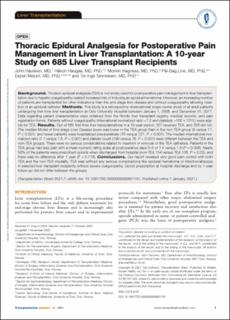| dc.description.abstract | Background. Thoracic epidural analgesia (TEA) is not widely used for postoperative pain management in liver transplantation due to hepatic coagulopathy-related increased risk of inducing an epidural hematoma. However, an increasing number of patients are transplanted for other indications than the end-stage liver disease and without coagulopathy allowing insertion of an epidural catheter. Methods. This study is a retrospective observational single-center study of all adult patients undergoing first-time liver transplantation at Oslo University Hospital between January 1, 2008, and December 31, 2017. Data regarding patient characteristics were obtained from the Nordic liver transplant registry, medical records, and pain registration forms. Patients without coagulopathy (international normalized ratio <1.5 and platelets >100 × 109/L) were eligible for TEA. Results. Out of 685 first-time liver transplantations in a 10-year period, 327 received TEA, and 358 did not. The median Model of End-stage Liver Disease score was lower in the TEA group than in the non-TEA-group (9 versus 17, P < 0.001), and fewer patients were hospitalized preoperatively (16 versus 127, P < 0.001). The median international normalized ratio (1.1 versus 1.6, P < 0.001) and platelet count (190 versus 78, P < 0.001) were different between the TEA and non-TEA groups. There were no serious complications related to insertion or removal of the TEA catheters. Patients in the TEA group had less pain with a mean numeric rating scale at postoperative days 0–5 of 1.4 versus 1.8 (P = 0.008). Nearly 50% of the patients were prescribed opioids when discharged from hospital (non-TEA 154 versus TEA 158, P = 0.23), and there was no difference after 1 year (P = 0.718). Conclusions. Our report revealed very good pain control with both TEA and the non-TEA modality. TEA was without any serious complications like epidural hematoma or infection/abscess in selected liver transplant recipients without severe coagulopathy. Opioid prescription at hospital discharge and by 1-year follow-up did not differ between the groups. | en_US |

